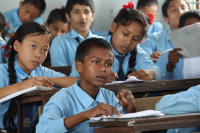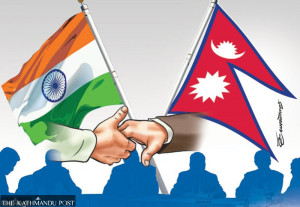Columns
The electric vehicle tax
The government has taken all the wrong steps in trying to curb air pollution.
Kritagya Shah
On January 4, Kathmandu’s air quality sank to its worst level, hitting 500 on the Air Quality Index. Much of this pollution had to do with the open fires that had gone unchecked for more than a month. But even before that in 2018, Kathmandu was ranked among the 10 worst polluted capitals in the world. Vehicular emissions are responsible for 70 percent of the air pollution in the Kathmandu Valley, which holds more than 48 percent of all the automobiles in the country. These numbers are vividly demonstrated in the horrendous traffic the Valley sees every day and the steady decline in air quality. How then can we begin to address the issue of air quality in Kathmandu? Electric vehicles 'were' to be the solution.
In 2018, Prime Minister KP Oli had pledged to turn 20 percent of the motor vehicles in Nepal to electric by 2020. Ironically, taxes on electric vehicles were raised so high they became as expensive as gasoline-powered automobiles, if not more expensive. The government did not roll back the tax on electric vehicles to the pre-lockdown structure but introduced a new progressive tax starting at 42 percent. This has affected the demand for electric vehicles which had risen to 10 percent of all sales.
International commitments
These positive steps were also working towards honouring Nepal’s commitments under the Paris Agreement of the United Nations Framework Convention on Climate Change (UNFCCC). As per Nepal’s Nationally Determined Contribution, it aims to reduce air pollution by 2025 and promote renewable resources. Nepal submitted its second Nationally Determined Contribution on December 8, 2020, in which it has pledged $3.4 billion in the form of unconditional commitment to achieve its targets.
As a least developed country, Nepal is not required to make such massive financial commitments as per the universally accepted principle of Common but Differentiated Responsibilities and Respective Capabilities, which recognises the developed countries as the major contributors to climate change and hence the most responsible. On the one hand, the government is making massive environmental-friendly economic commitments in the form of Nationally Determined Contribution commitments while, on the other hand, it is increasing taxes on electric vehicles which will work against these same commitments.
This electric vehicle tax increase decision not only works against Nepal's Nationally Determined Contribution, it also harms the national economy. For the first time in 2020, electricity production of Nepal had reached a surplus, resulting in the Nepal Electricity Authority's losing potential revenue of Rs2 billion per month due to lack of energy demand during the lockdown. The then managing director Kulman Ghising had even appealed to the public to increase power consumption by making greater use of electric vehicles with plans being made to set up charging stations for electric vehicles throughout the country. He also highlighted the importance of government policy and support to shift to battery-powered vehicles to reduce external dependence on fossil fuels.
Currently, petroleum ranks among Nepal's top five imports. Gasoline sales have almost doubled in the last five years. This has only increased Nepal’s external dependency, further causing a severe jump in Nepal’s trade deficit. In 2018, Prime Minister KP Sharma Oli’s address at the launch of battery-powered public buses under Sajha Yatayat also marked the launch of the National Action Plan for Electric Mobility. In his address, he spoke of Nepal’s independence in hydropower in the next few years which would benefit the economy, environment and public health and 'leave behind' Nepal’s reliance on fossil fuel. However, shortly after that, his administration failed to capitalise on the economic potential of surplus hydropower by jacking up taxes on electric vehicles and saw a record rise in air pollution in Kathmandu.
Multiple studies have also drawn a causal link between Covid-19 and air pollution. A study by Harvard University has stated that increased air pollution has a direct link with increased Covid-19 death rates. Another study by the University of Bologna has suggested that air pollution particles carry the virus over long distances which result in the increased spread of Covid-19.
In these testing times, the promotion of electric vehicles isn’t the solution to all the problems. However, it was a great start. As per a USAID report, Nepal has the potential to generate over 40,000 megawatts of electricity through hydropower. Such potential when harnessed would truly benefit the economy, environment and public health of Nepal when electric vehicles reap the major benefits from it. The previous year already witnessed a surplus generation of electricity, and subsequent years will generate even more electricity with more hydropower plants under construction. Nepal’s neighbours, India and China have also committed to electrifying a majority of their vehicles by 2030. With increased capacities in hydropower generation, Nepal could eliminate its trade deficit as the world moves further towards renewable energy.
Ready for the future
Thus the mass adoption of electric vehicles ties up intrinsically with various impacts such as clean air, reduced fossil fuel dependency, improvement in the trade balance, the fulfilment of more extensive international commitments, and reduced carbon emissions. With cleaner air, the beauty and attraction of Nepal would be further amplified, providing an improved attraction for tourism.
Mass adoption of electric vehicles could also pave the way for domestic production of electric vehicles as the technology for manufacturing them becomes more straightforward. In 2019, Yatri Motorcycles, a Nepali start-up, built the first domestically designed electric motorcycle. This depicts the steps Nepal had begun to take to benefit from the country’s hydropower potential and tax incentives prior to the electric vehicle tax hike. We don’t have to look very far to understand the implications of cleaner air in Kathmandu and all over Nepal. The air pollution record of January 4 amply shows us what is, whereas the lockdown provided us with a wonderful opportunity to see what could be. Electric vehicles are the future. Nepal, with its massive hydroelectric power potential, would be more than ready for this future if the right steps are taken now.




 6.12°C Kathmandu
6.12°C Kathmandu















